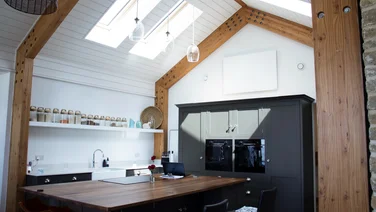- Infrared underfloor heating generally costs around £75 per square metre
- Infrared heating systems only take 3-5 minutes to get up to full heat intensity
- Infrared heating generates fewer carbon emissions than gas boilers
Infrared is the underdog in the domestic heating scene, which is a shame because the infrared heating panels cost less than other low-emission tech. While 93% of Brits are aware of low-carbon tech (The Eco Experts National Home Energy Survey, 2024), most were unaware of this great alternative to electrical domestic heating.
If you are looking at cutting your bills (and can’t afford and/or are not eligible for free heat pumps or solar panels), infrared panels are another option you could explore.
If you’re considering installing infrared heating in your home, consider underfloor heating. It’s efficient, low-maintenance, and can significantly reduce your carbon emissions. If this is you, our comprehensive guide below will tell you everything you need to know about infrared underfloor heating, from how it works to how much it will cost.
If you think your home would be better suited to infrared panels, we can help you there, too. To receive free infrared panel quotes, just fill out this short form with a few quick details, and our installers will contact you with their best prices.
Get free infrared panel quotes
Answer a few quick questions, and our trusted installers will send you bespoke infrared panel quotes – for free.

What is infrared underfloor heating?
Before we get into the infrared nitty-gritty, let’s discuss underfloor heating. An underfloor heating system does exactly what it says on the tin—it heats your home through a system installed under the property’s flooring.
This modern heating technology is designed to keep properties warm more economically and effectively than convection heating. It does this by evenly dispersing low-wattage energy across a large surface area, warming the room.
Manufacturers have now paired this underfloor heating system with the relatively new concept of infrared heating. These infrared underfloor heating systems work like electric underfloor heating systems, except they use radiant heating, directly transferring heat to objects and people rather than heating the air.
And if you’d like to consider other alternatives, you can check out our page on infrared wallpaper.
How much does infrared underfloor heating cost?
Infrared underfloor heating generally costs around £73 (or between £60 and £85) per square metre, according to Checkatrade. Considering the average UK living room is 17.1 square metres, it could cost you around £1,250 just to install infrared underfloor heating in this one room.
It’s also important to consider labour costs when installing any underfloor heating system. This may or may not be included in any quotes you receive, so check them with a fine toothcomb.
Unlike regular infrared panels, which can just be propped onto the wall and hooked up to an electric circuit, underfloor heating systems have a slightly more complicated installation process – which will only add more money to the final price tag.
Want a better idea about how cost-effective underfloor infrared heating is? Check out our infrared heating panel costs page to compare prices.
How is infrared underfloor heating installed?
Regarding infrared underfloor heating, most people choose to install infrared film under the flooring.
Once the existing flooring has been removed, the infrared film can be installed in a few simple steps:
- Prepare the base—Before the installer can start installing the infrared heating film, they’ll need to place a layer of insulating material on the base, which will prevent heat from escaping through the floor slabs.
- Lay out the infrared system – Once the base is done, the installer will need to roll out the infrared heating film and cut it into individual fragments, which should be laid across the room.
- Connect the system to an electrical circuit—The installer will then connect a conductor to a copper clamp on each infrared film strip, enabling electrical current.
- Mount the control device—The installer will then fix a thermal sensor underneath the sheet of films to ensure the heat regulator works properly.
Once the installer has completed these steps and the system has been successfully tested for faults, they can replace the flooring on top of the film. Since infrared heating film has a lifespan of 45-50 years, you won’t have to worry about replacing it anytime soon.

Advantages and disadvantages of infrared underfloor heating
| Pros | Cons |
|---|---|
Reduces emissions | It’s expensive |
Low maintenance | Property needs to be well insulated |
More efficient than central heating systems | You can’t ‘zone’ your heating |
Doesn’t ruin aesthetics | Runs on electricity, which is expensive |
Suitable for most homes | |
No noise pollution | |
Can be paired with solar panels |
Advantages of infrared underfloor heating
- Reduces emissions – Over three-quarters of UK residents are anxious about climate change, and switching to infrared panels can help shrink your carbon footprint. Thanks to their high efficiency, infrared heating systems reduce emissions by consuming less energy, with top models reaching 100% efficiency.
- Low maintenance – With no moving parts, infrared heating systems have minimal wear and tear, often eliminating the need for regular servicing, unlike boilers and heat pumps.
- More efficient than central heating – Infrared panels heat objects directly rather than warming the air, making them more efficient than central heating systems. They also reach full heat intensity in just three to five minutes.
- Doesn’t ruin aesthetics – Infrared underfloor heating systems are discreet, eliminating the need for bulky radiators or boilers, and they remain completely out of sight.
- Suitable for most homes – Infrared underfloor heating works for various properties, from modern new builds to traditional cottages, provided they are well-insulated. Listed property owners can also install these systems with temporary flooring removal.
- No noise pollution – Infrared systems operate silently, which is ideal for flats or quiet neighborhoods.
- Can be paired with solar panels – Infrared heating can be connected to existing solar panel systems to reduce bills and emissions further. For homes without solar panels, installation will require a significant upfront investment. Want to learn more? Check out our Solar Panel Costs page for more information.
Disadvantages of infrared underfloor heating
- It’s expensive – Underfloor heating costs around £75 per square meter, with the overall price varying based on the number of rooms covered. Additional expenses include removing existing flooring for installation and refitting it afterward.
- Requires good insulation – Homes must be well insulated for infrared underfloor heating to work effectively. Adding insulation can cost from a few hundred to several thousand pounds. According to one IR supplier Herschel, the benefits of this system drop significantly without proper underlying insulation or thermal mass.
- No heating zones—Unlike regular infrared panels, which allow for “zoning” (heating specific rooms), underfloor heating systems operate as an all-or-nothing solution. For better flexibility, regular wall —or ceiling-mounted infrared heating panels might be a better choice.
- Runs on electricity, which is expensive – Infrared systems rely on electricity, which is currently more expensive than other fuels due to the ongoing energy crisis. While these systems are efficient and reduce energy usage, they may still increase energy bills compared to gas boilers.
Infrared vs electric underfloor heating
Infrared underfloor heating is very similar to its electric counterpart. They work similarly, except that infrared radiation is emitted directly to heat objects rather than heat the air.
Infrared underfloor heating offers a few advantages over standard electrical ones. As outlined in the table below, it’s a much more efficient heating method, leading to more energy savings over time.
The first two table entries are for non-infrared electrical underfloor heating. The final row is an IR panel heater, but running costs will be similar to comparable underfloor heating.
| Heating system | Wattage (kW) | Cost to purchase | Operating cost |
|---|---|---|---|
| Underfloor electric heating 100W per m² | 2.2 | £1,410** | £1.54 per day |
| Underfloor electric heating 200W per m² | 4.4 | £1,612** | £3.08 per day |
| Infrared heating panel | 1.2–1.4 | £687 | £0.94 per day |
*These costs, sourced from Herschel, aren’t subject to energy crisis increases and are based on a living room size of 22.4m2. They are also based on running for 5 hours a day, which will be considerably more in the height of winter.
**This price excludes insulation and substrate layers required for underfloor heating
Is your home suitable for infrared underfloor heating?
- If infrared underfloor heating is starting to sound like a good option for your home, you’re lucky – it’s suitable for most UK properties.
- Underfloor heating can be fitted in both new and old properties. However, the actual floor—such as tile, laminate, or vinyl—will need to be removed and replaced, which is something people in listed buildings might not be allowed to do.
- Infrared underfloor heating systems can also be installed in every room in your home, whether on the ground floor, basement, or upper levels.
Summary
- Infrared underfloor heating costs approximately £75 per square meter, with additional expenses for labor, insulation, and removing and replacing flooring. Installation is more complex than standard infrared panels, which increases the overall cost.
- Infrared systems are highly efficient, heating objects directly instead of the air, reducing energy usage and carbon emissions. They reach full heat intensity in just 3-5 minutes and are more economical than many other low-carbon heating technologies.
- These low-maintenance systems operate silently and blend seamlessly with home aesthetics as they are hidden under the floor. They are suitable for most homes, provided the property is well-insulated.
- Infrared underfloor heating cannot “zone” heating to specific rooms and runs on electricity, which is currently expensive. Proper insulation is essential to maintain efficiency, and listed buildings may face restrictions on flooring modifications.
- Regular infrared heating panels might better suit homes needing zoning flexibility. They are less costly to install and can complement solar panels to further reduce carbon footprints and energy bills.
Sound good? Get the ball rolling by using our easy-to-navigate tool. All you have to do is pop a few quick details in the form, and our expert installers will be in touch with free quotes.
If you’re still on the fence about whether to invest in infrared heating, check out some of our helpful guides below to get a better idea of what they have to offer:
- A Beginner’s Guide to Infrared Heating Panels
- The Advantages and Disadvantages of Infrared Heating Panels
- Infrared Heating Panel Costs
- Should You Get Infrared Heating Panels?
- The 6 Best Infrared Heating Panels
FAQS
- Is infrared underfloor heating expensive to run?
Due to its high efficiency, infrared underfloor heating is generally more cost-effective to run than traditional heating systems. This is primarily because it is less wasteful to heat objects directly than indirectly by heating the air first.
However, since it runs on electricity, operating costs can be higher than gas systems, especially during an energy crisis. For example, heating a 22.4m² living room for five hours a day costs around £0.94 per day. While it’s efficient, electricity prices significantly impact running costs.
- Does infrared underfloor heating use a lot of electricity?
Infrared underfloor heating uses less electricity than other electric systems because of its direct heat transfer method, which avoids energy loss. The system’s efficiency ensures less energy is needed to achieve the desired warmth.
For example, a 1.2–1.4 kW wattage system can sufficiently heat a medium-sized room. Despite the lower consumption, electricity prices may still make it relatively expensive compared to gas heating.




